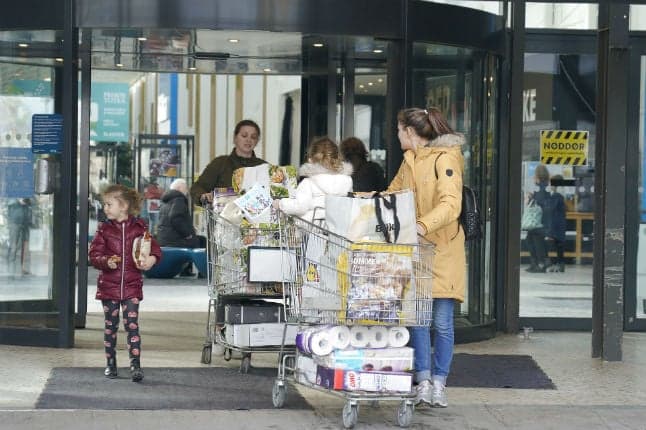Coronavirus: Danish government calls for end to hoarding

Denmark's government has called on people to stop hoarding food and other essentials after supermarkets were hit by a sudden rush on Wednesday night.
"We encourage people to shop normally and to follow the current advice," Food Minister Mogens Jensen said at a press meeting on Thursday morning. "There is no problem with the security of supply at our stores, but there is a problem with hoarding."
Following the announcement of far-reaching measures to slow the spread of coronavirus on Wednesday night, supermarkets across Denmark faced an onslaught of shoppers, stripping the shelves of some items.
The panic to secure supplies was so intense that police were called to a branch of Netto in Odense on the island of Funen, and to a supermarket in southern Jutland where a group of customers refused to leave at closing time, according to Denmark's state broadcaster DR.  A collage of empty shelves in Danish supermarkets after a spate of hoarding on Wednesday night. Photo: Mads Claus Rasmussen/Scanpix.
Danish Twitter was on Wednesday night and Thursday morning filled with images of supermarket queues and empty shelves.
A collage of empty shelves in Danish supermarkets after a spate of hoarding on Wednesday night. Photo: Mads Claus Rasmussen/Scanpix.
Danish Twitter was on Wednesday night and Thursday morning filled with images of supermarket queues and empty shelves.
Yo Danes can you please stop hoarding toilet paper too? We are raised better. pic.twitter.com/bGXbyMvMTk
— Terry (@teddyrised) March 11, 2020
Hoarding has started in Denmark #COVID19dk pic.twitter.com/ijOYivbQUc
— Dr Anuja Pradhan (@anujap) March 11, 2020
The country's leading supermarkets, Salling Group, Coop, Dagrofa and Rema 1000, on Wednesday a joint press release assuring consumers that they had adequate supplies of all products, asking them not to change their shopping habits.
"We will all throughout the supermarket industry make sure that we remain continuously stocked," Dagrofa said in a tweet.
I dag gik vi ud sammen med vores kollegaer i branchen for at fortælle vores kunder, at der er varer nok i de danske butikker, hvis vores kunder handler som de plejer. Vi sørger alle for at fylde op løbende i hele dagligvarebranchen. #dagrofa #meny #spar #minkøbmand https://t.co/OzrIRaqnPi
— Dagrofa (@Dagrofakom) March 11, 2020
Simon Kollerup, Denmark's Minister for Industry, Business and Financial Affairs, on Thursday urged "calm and sanity".
"The government is in close contact with the retailers and the government, and the message from the supermarkets is clear: The shops are open as usual," he told the Ritzau newswire. "There are items in stock and the trucks are operating as normal. There are enough goods for everyone."
Comments
See Also
"We encourage people to shop normally and to follow the current advice," Food Minister Mogens Jensen said at a press meeting on Thursday morning. "There is no problem with the security of supply at our stores, but there is a problem with hoarding."
Following the announcement of far-reaching measures to slow the spread of coronavirus on Wednesday night, supermarkets across Denmark faced an onslaught of shoppers, stripping the shelves of some items.
The panic to secure supplies was so intense that police were called to a branch of Netto in Odense on the island of Funen, and to a supermarket in southern Jutland where a group of customers refused to leave at closing time, according to Denmark's state broadcaster DR. 

A collage of empty shelves in Danish supermarkets after a spate of hoarding on Wednesday night. Photo: Mads Claus Rasmussen/Scanpix.
Danish Twitter was on Wednesday night and Thursday morning filled with images of supermarket queues and empty shelves.
Yo Danes can you please stop hoarding toilet paper too? We are raised better. pic.twitter.com/bGXbyMvMTk
— Terry (@teddyrised) March 11, 2020
Hoarding has started in Denmark #COVID19dk pic.twitter.com/ijOYivbQUc
— Dr Anuja Pradhan (@anujap) March 11, 2020
The country's leading supermarkets, Salling Group, Coop, Dagrofa and Rema 1000, on Wednesday a joint press release assuring consumers that they had adequate supplies of all products, asking them not to change their shopping habits.
"We will all throughout the supermarket industry make sure that we remain continuously stocked," Dagrofa said in a tweet.
I dag gik vi ud sammen med vores kollegaer i branchen for at fortælle vores kunder, at der er varer nok i de danske butikker, hvis vores kunder handler som de plejer. Vi sørger alle for at fylde op løbende i hele dagligvarebranchen. #dagrofa #meny #spar #minkøbmand https://t.co/OzrIRaqnPi
— Dagrofa (@Dagrofakom) March 11, 2020
Simon Kollerup, Denmark's Minister for Industry, Business and Financial Affairs, on Thursday urged "calm and sanity".
"The government is in close contact with the retailers and the government, and the message from the supermarkets is clear: The shops are open as usual," he told the Ritzau newswire. "There are items in stock and the trucks are operating as normal. There are enough goods for everyone."
Join the conversation in our comments section below. Share your own views and experience and if you have a question or suggestion for our journalists then email us at [email protected].
Please keep comments civil, constructive and on topic – and make sure to read our terms of use before getting involved.
Please log in here to leave a comment.